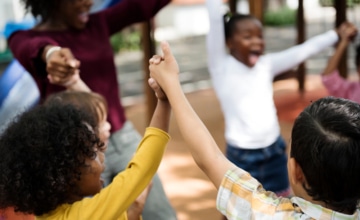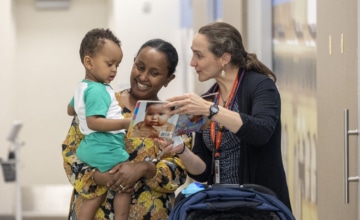by Janice Im, Rebecca Parlakian, and Sylvia Sánchez
Everyone brings specific values, beliefs, and assumptions about child rearing and child development to their work with infants and toddlers. What impact do cultural differences have on child development and those who care for young children?
An example of when caregivers could face cultural differences in child development practices:
Lisa and Danielle are collegial co-teachers in an infant and toddler classroom. Occasionally what seem like minor issues cause them to make some pointed comments that silence them both. For example, Lisa believes that babies need to be held and cuddled as often as possible; she carries them throughout the day or picks them up at the first sign of fussiness. She frequently observes aloud, “Babies need lots of love and attention.” Danielle responds by rolling her eyes and saying, “They also need to learn to soothe themselves. You’re going to spoil them if you pick them up and carry them all the time.”
Their different views about feeding can also lead to minor conflicts. Lisa refuses to let babies eat with their fingers. She thinks they won’t get enough to eat and that it’s too messy. Danielle lets babies pick up food off their trays as soon as they are able, stating that “it helps them to develop independence and small muscles.”
Why do Lisa and Danielle each get exasperated with the other’s “illogical” way of thinking? Their own upbringings and cultural perspectives about children influence their views on everyday activities such as holding, responding to, and feeding infants and toddlers.
Everyone brings specific values, beliefs, and assumptions about child rearing and child development to their work with infants and toddlers. Even two teachers who share the same ethnic culture may not share the same beliefs about what is best for young children. Conflicts around these issues can arise with colleagues and families in early care and education programs. Recognizing and acknowledging another person’s point of view and coming to a shared solution is critical in providing high-quality care to infants and toddlers.
The roots of caregiving
It is helpful to understand and explore two particular areas when caring for infants and toddlers—self-knowledge and knowledge of culturally-informed teaching (Abt-Perkins & Rosen 2000).
Self-knowledge
Self-knowledge is defined here as “a thorough understanding of one’s own cultural roots and group affiliations” (Haberman & Post 1998). Before we as teachers can address the needs of very young children, we must first become more aware of our own cultural beliefs and practices. By taking a good look at our early relationships and childhood experiences, we can recognize the influence that these factors have on our role as caregivers, as well as on our feelings, attitudes, and beliefs about children.
The people we were close to as we grew up—and our experiences with them—shape who we are today. Most of us still believe much of what those special people taught us about ourselves, other people, and the world. The messages our caregivers conveyed in words and actions reflected their cultures, beliefs, values, and attitudes—and these views become a part of us. When our culture differs from that of a colleague or child and family in our program, it may create a barrier to understanding how best to support children’s learning (Orange & Horowitz 1999). A colleague can be a great asset in the journey to understanding oneself. Teachers and caregivers who work together can take time to reflect on and discuss questions such as the following:
- What do I believe a child can do and not do at this particular age?
- What child behaviors do I feel are acceptable and not acceptable—why?
- Should boy babies be treated differently from girl babies? If so, in what ways?
- What do I believe about how to best care for, support, and nurture the children in our program? How are my beliefs the same as or different from yours?
Reflecting on our own cultural beliefs and practices about caring, teaching, and learning can help us recognize the cultural perspective we bring to our work. Only then can we begin to address any preconceived notions that make it difficult to accept, understand, and effectively support the children and families we serve (Willis 2000).
Understanding Cultural Influences on Child Development
Knowledge of culturally informed teaching comprises the information a caregiver needs to create a learning environment that welcomes children from diverse cultures. This environment includes not only the physical setup of the classroom, but also a culturally sensitive pattern of caregiver–child interactions and the use of approaches that engage and encourage the participation of children from a variety of cultures. Culturally informed teaching strategies help us individualize learning experiences based on each child’s needs. Delpit (in Willis 2000, 6) notes, “The question is not necessarily how to create the perfect ‘culturally matched’ learning situation for each ethnic group, but rather how to recognize when there is a problem for a particular child.” As we get to know different children, families, and cultures, we may find our caregiving practices challenged in various ways.
For instance, having learned to value and support autonomy and independence, a teacher encourages young toddlers to feed and dress themselves. She believes this practice builds pride and self-esteem. Then, a toddler from a culture in which children are generally hand-fed and dressed by their families into their kindergarten year enters the program. The family’s cultural beliefs value interdependent love, and they want their children to understand the meaning of giving and receiving help. Both approaches can benefit children.
Talking with families about their cultural practices, traditions, and beliefs provides the message that they are valued. However, just talking with families may not be enough. Teachers need to understand cultural influences on child development and be open to and accepting of different ways of caring and teaching, and thoughtfully explore the many ways to help children and families feel welcome. Visiting the families’ communities and inviting families to share what they believe is important for their children to learn and achieve are the first steps for teachers in building a knowledge of families’ cultures. From these interactions and observations, teachers can gain an understanding of the strengths children and families bring with them to the program. Such knowledge can help teachers provide care and support that honor and celebrate families’ cultures.
Think First
- Think about your own family and how you were brought up. How have your beliefs, attitudes, and values about how to care for and support infants and toddlers changed or stayed the same over the years? What brought about the changes or reinforced what you already believed?
- Think about other cultures. Recognize that there are differences and similarities among all cultures. When you feel yourself judging a practice that a colleague or a family prefers, or a family’s request for how they want their child cared for, stop and ask yourself: Could this be a culture bias of mine? Do I really understand what this family is asking and why? Explore your feelings and potential biases about others’ practices in regard to child rearing and your own beliefs about how infants and toddlers should be cared for.
Try It
- Share information about your own culture, beliefs, and practices. Make a book about you and your family and share it with your colleagues and the children and families in your program.
- Encourage families to discuss their culture with you. Ask questions and listen closely without judgment. Ask families how you can support their children’s learning and development. Be open to, and include, a variety of approaches in your caring practices.
- Suggest that a staff meeting be scheduled around this topic and discuss your beliefs with your colleagues.
Conclusion
Every interaction that a teacher has with a child or a colleague is a cultural exchange. How we diaper, our expectations for children’s behavior, the topics or issues we choose to discuss with families—all are a reflection of our cultural beliefs.
If we go back to our opening scenario, Lisa and Danielle would benefit from taking time to discuss the beliefs behind the caregiving decisions they make. By doing so, they can begin to establish a shared understanding and, in time, appreciation for why each operates the way she does. It is an ongoing process of self-awareness, learning, and discovery that is repeated at intervals throughout our professional careers. This process of exploration and questioning may not be simple or easy, but it is an essential part of working respectfully and effectively with young children and their families.
References
- Abt-Perkins, D., & L. Rosen. 2000. Preparing English teachers to teach diverse student populations: Beliefs, challenges, proposals for change. English Education 32 (4): 251–66.
- Haberman, M., & L. Post. 1998. Teachers for multicultural schools: The power of selection. Theory into Practice 37 (2): 96–104.
Orange, C., & R. Horowitz. 1999. An academic standoff: Literacy task preferences of African American and Mexican American male adolescents versus teacher-expected preferences. Journal of Adolescent and Adult Literacy 43 (1): 28–39. - Willis, A. 2000. Critical issue: Addressing literacy needs in culturally and linguistically diverse classrooms. Online: www.ncrel.org/sdrs/areas/issues/content/cntareas/reading/li400.htm.



